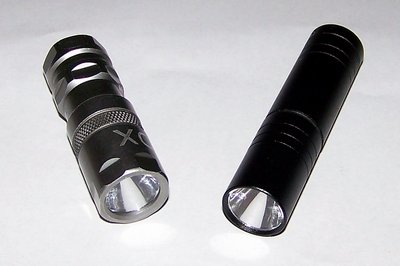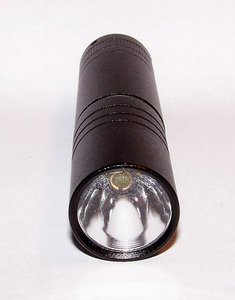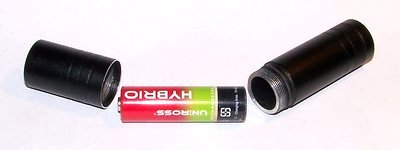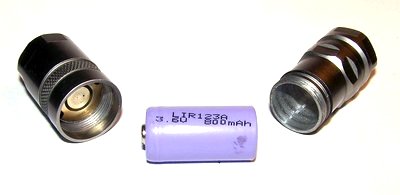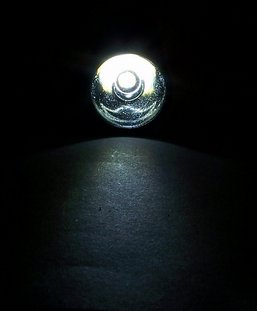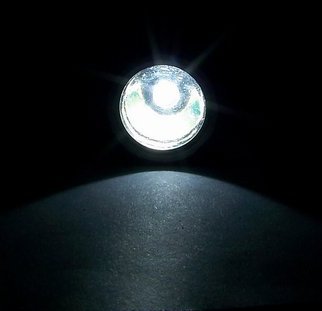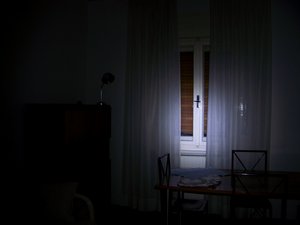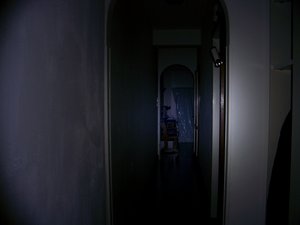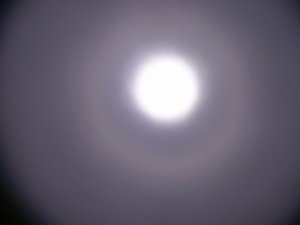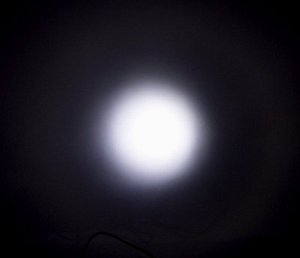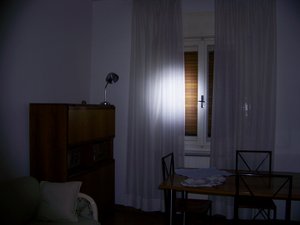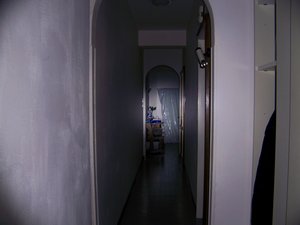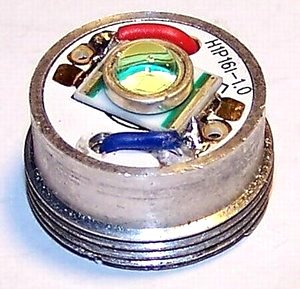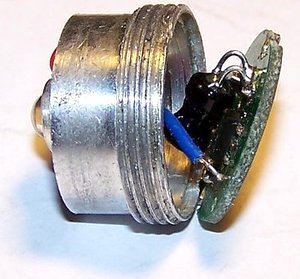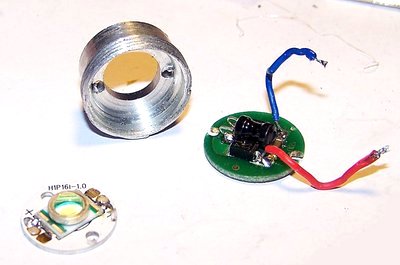TechNFun - Fun with technology
Electronic gadgets reviewed and modified
Reviewed on:
21st April 2008
More cheap LED flashlights
1W and MXDL Cree flashlights
Small 5mm LEDs are interesting and practical but, let's face it, not terribly impressive. Yes, they can be surprisingly bright, but you still need arrays of them for anything more than penlight brightness.
Positively huge arrays, when manufacturers adopt the "more is better" philosophy and come up with ridiculous showerhead monstrosities like these.
That is, you'll be unsurprised to learn, not the most effective way to get lots of light from LEDs.
Lumileds, Philips' LED division, came out with the Luxeon high-power LEDs about six years ago. They made it possible to build flashlights that gave as much light as a reasonable 5mm array with just one emitter. Luxeons were a huge success; they weren't powerful enough to challenge high-performance incandescent bulbs yet, but they started the ball rolling.
As usual, chinese knockoff manufacturers soon started building their own versions, less efficient but much cheaper.
Fast forward six years, and high-power LEDs have evolved to the point where a single one can make more light than most incandescent flashlight bulbs; the big names today are Cree and Seoul SemiConductor.
There are still cheap Luxeon knockoffs around, but they've undergone surprisingly little change in the last six years of technological innovation. What has changed is their price: already cheap in the beginning, they now cost mere pennies, and are therefore liked by Chinese enterprises looking to make medium power flashlights with $2 worth of parts.
Here we have a high-power LED flashlight made by MXDL with a genuine Cree LED in it (the small, grey one) and a medium-power one with a supercheap Luxeon knockoff known only as "1W" (the black one).
They both came from that magical place known as DealExtreme, where electronic gadgets grow on trees. All they have to do is pluck them and send them off, hence their incredible cheapness.
"1W" here means one watt, which is the energy the LED uses. It's a lousy name, but since it has no markings and that's how DealExtreme call it, it's the only one it has.
It runs from a single AA cell, and it has a boost circuit to get the voltage to the 3.6V or so that the LED wants.
The body is completely cylindrical, which gives the light a tendency to roll away at the slightest provocation.
It also has no knurling whatsoever; since the switch is a twistie, and a pretty hard one at that, this is particularly annoying. You need to have a very firm grip to operate the light; if you have dirt, dust or grease on your hands you'll be wrestling with it for a while before you can turn it on.
The back end is flat, so you can tailstand it for ceiling-bounce mode (where the beam is directed at the ceiling and the reflection illuminates the room). There's the usual lateral hole for a lanyard.
The threading is not very good. It squeaks, it rattles, it feels rough and it's thinner than it needs to be, so you need to take extra care to avoid cross-threading.
Still, it's not as if it doesn't work. The circuit appears reliable, and I have experienced no flickering or otherwise incongruous operation.
The LED is as unlikely to be damaged by physical shock as any other LED; I also dropped the light twice from about arm height (by accident, not as part of the review process) and it didn't stop working.
The light is not water-sealed. There is an o-ring inbetween the body and the head, but it's too narrow and doesn't actually make contact, so water would easily get inside if the light got dunked.
The 1W is about as bright as flashlights using genuine old Luxeon Is are, which is to say, not much.
Not much when compared to the current competition, that is; compared to small arrays of ordinary 5mm LEDs the 1W is still a rather good performer, lumen-wise. Beam colour is also nice, with a slight blue tint which is, in my opinion, far better than the sickly green beam many Luxeon Is used to have.
Then again, what colour you get might depend on luck. Back in the days of Luxeons you could buy two identical lights and find out one was slightly brighter and bluer, and the other slightly dimmer and greener. This phenomenon was dubbed the "Luxeon lottery" by enthusiasts, and all you could do about it was hope.
I'm not sure if there is such a thing as a Luxeon-knockoff lottery, but if there is I obviously got a good ticket.
One thing I don't like about it is that it gets rather hot. Uncomfortably so, even, if you're particularly sensitive. I don't think it's the LED - rather, I think it's the boost circuit. Cheapo boosters are known for their horrendous efficiency, and what energy they waste becomes heat.
The twistie switch is single-mode. The relatively gentle output doesn't make the lack of a low mode a terrible shortcoming, but full power might still be a bit too much in certain situations, and a low-power mode would also help preserve battery power. Oh well.
This flashlight is a pre-modded version of a previously existing one. It was originally a three-watt Luxeon-knockoff flashlight, but then its generic LED (presumably the same used by the 1W) was replaced with a genuine Cree P4 and the reflector bored out to fit.
How do I know? Well, because DX still have the original on sale. Oh, and because they flat out say it on the Cree MXDL's product page.
Flashlight modding can be trickier than it looks like. If you just swap out the emitter with another one you can have voltage and current issues, problems with inadequate heat sinking and reflector incompatibilities that cause all sorts of weird beam artifacts.
I'm pleased to report that this here modded flashlight is not a half-assed hack job. Whether by skill or by luck I can't say, but the result is really quite good.
The emitter, a Cree P4, is driven about as hard as it should be, the light's body gets warm (it's a good thing; it means the LED is sinking its excess heat in the metal of the body, instead of leaving the body cold and barbecuing itself) and the beam, while a slight bit unusual, is not ugly.
The MXDL is not a new model, and so it doesn't use the latest emitter. P4s are no longer on the cutting edge; the best and brightest Crees that normal people can buy now are Q5s, with the even better R2s now finally becoming somewhat available (though still not mainstream).
The Cree roadmap shows that Q5s are about 20% more efficient than P4s.
Well, whoopee.
Thanks to the way our eyes work, a 20% difference in brightness is not as significant as many people think. You'll probably see a small difference if you put a P4 flashlight close to a Q5 one, turn them both on and look at the beams. You'll have a much harder time noticing anything if the lights are turned on separately.
In other words: there's little reason to worry about the "old" P4 LED in the MXDL, unless you're one of those people who must, as a matter of principle, always have the bestest there is, lest they can't compensate enough.
I got the MXDL Cree about a year ago. Back then, the only superLED light I owned was a Fenix L1S, a Luxeon I flashlight whose maximum power is, while sufficient for my needs at the time, nothing to be astonished about.
That, coupled with the fact that it's human nature to instinctively (and stupidly) assume that smaller things must be less performing than bigger things, caused me to be caught unprepared. I got the MXDL out of its package, popped in a battery and turned it on while - need I even say it - looking straight at the emitter.
I think I can still see yellow spots if I close my eyes.
The little sucker is bright. As in, illuminates-houses-a-block-away-at-night bright.
I've handed it to some people, and two things invariably happen: they blind themselves by doing the same stupid thing I did, followed by commenting on how powerful and cool and small the thing is.
And small it is, as you can see from the above picture. Actually, I believe it might be one of the smallest CR123 Cree lights in existence. It's hard to really draw a winner, as there are many similar lights around, but the MXDL is definitely a contender to the record.
Its diminutive size comes from the use of a CR123A cell (of which I talk about in the "Power" section below) and from its twistie operation.
Clicky lights need a switch assembly on their end, and the mechanism takes space. All twistie lights need is a flat conducting bottom, so they can have very short bodies. The MXDL doesn't even have a tailcap; the battery tube is closed at the end, and that's it (which means it can tail-stand just fine).
Along with the small size, the twistie action also gives the MXDL higher than average resistance to damage: switches and mechanisms that aren't there can't break.
If you unscrew the battery tube (which has a lanyard hole at the end, by the way) just enough that it switches off the light, it's possible to then hold the MXDL as you would a cigar and push on the end of it with your thumb for tactical use (momentary operation).
Many lights with active circuitry and powerful emitters have more than one mode of operation - typically three, with the other two being medium and low. Not the MXDL, though; it's full-power only.
Now, a powerful beam is good in many situations, and it's definitely fun to use it to retaliate against people whose idea of a joke is to flash you in the eyes with Maglites, but it can be highly undesired in many other situations.
Reading, for instance, doesn't require much light; a big white splotch in the middle of your page is just going to annoy the hell out of you. It's also no good if you're doing precision work, as it'll reflect off whatever you're working on and blind you.
I'm sure you can think of many more applications where a dim light is much more desirable than a bright one.
You can get around this limitation by shining the MXDL's beam on the ceiling or wall and reading/working in its reflection, but that's a highly inefficient method and it's
no good if you have enemy soldiers sleeping roommates around.
The flashlight's build quality is OK. The battery tube moves a bit when the light is off, but it doesn't come off unless you unscrew it all the way. The body is all metal and the threading feels well made and really smooth, due in part to the presence of an o-ring, which also provides a better-than-nothing water seal.
The only thing I don't like about it is that it has a cheap plastic lens instead of a tougher, more transparent glass one. The plastic lens is easy to scratch, and scratches will deviate light in directions other than where it's supposed to go. The lens is also not glued in place, so it rattles a bit and water would have no trouble getting through it.
Some silicone sealant around it would probably make the MXDL adequately dunk-proof, and swapping the lens for a glass one would be very easy for anyone with opposable thumbs.
The body is well machined. There's a line of knurling on the head, and there are hexagonal ridges on it and on the battery tube; all that makes it very easy to use the MXDL even if you have dirty hands. The hexagonal shape doesn't extend to the rest of the body, though, so the light will promptly roll away if placed on a sloping surface.
I used the MXDL for about a year, and I found it very reliable: it never flickered or dimmed, it always came on when I needed it, it never required shaking and/or bumping to work and I've yet to see problems with dirty contacts or threads.
The 1W runs on a single AA cell and draws about 600mA from a fresh alkaline and 400mA from a NiMH rechargeable. This means it's not a regulated light.
The circuitry in regulated lights will draw more current if the voltage decreases in order to keep driving the LED at the same power. This, of course, murders tired batteries, but ensures that when the light is on it's always at full power.
Many regulated lights take measures to prevent killing tired cells too quickly - some drop to a low-output mode when the cell starts getting seriously short of breath, others (often called "semi-regulated") stay at full power for however long the cell is comfortable with, then they switch to simple boost mode.
The 1W doesn't work like this, which isn't really surprising when you consider how cheap it is. It uses a simple boost driver - the circuit takes whatever voltage it's given, boosts it and feeds it to the LED. That's it.
The battery will thus last longer, but the beam will get progressively dimmer. This is better for situations where some light is better than no light at all, but it also means that using an AA cell with a lower nominal voltage (such as a 1.2V NiMH rechargeable) will never make the light work at full power.
Alkalines will make the 1W run at full steam for maybe half an hour, then you'll get several more hours of progressively dimming output. The point where you decide the light needs its AA replaced is entirely dependant on how dim a light you can stand.
Lithium AAs will make the 1W slightly brighter at the beginning, they'll stay at full power longer, and they'll give you more hours of dimming brightness.
Rechargeables have a much flatter discharge curve, and much less internal resistance. Tranlsated in english, this means they'll stay at close to their rated voltage for almost all of the discharge cycle, even under heavy load; when they do run out of steam, however, they'll drop to zero very quickly indeed.
So a 2000mAh LSD NiMH AA will run the 1W for four to five hours at about 3/4 of full power, and then the output will decrease rather quickly (non-LSD cells of higher capacity will, of course, last more if freshly charged).
I'm afraid things are a bit more complicated for the little Cree flashlight.
| In case you're wondering, the "123" number does not originate from a "let's think of how to call this cell so
people will remember it better" contest, although it's certainly good for that. The full name of these cells is CR123A, which can be disassembled like this:
-CR: indicates lithium chemistry -1: one cell (there are 6 volt CR223A batteries that are made of two cells in series) -23A: two thirds of an A-sized cell A cells are almost never seen, but they are nonetheless a standard. They are just as long as an AA cell, but slightly fatter and with a bit more capacity. |
The CR123A cells it uses aren't very exotic items, but you're still unlikely to find them at your local family-run grocery store.
Before "tactical" flashlights came along 123s were (and still are) used in photographic and medical equipment, where their relatively good tolerance for high draws, high energy density and extremely long shelf life (10 years quoted, rather more in reality) made them clear winners over the more common AAs.
All of those characteristics come from their lithium-based chemistry, which also gives them their 3v nominal voltage.
The problem is that the lithium chemistry also makes 123s expensive. Buy them in a specialized camera store and you'll pay through the nose (like, $8 each). You can find off-brand 123s online for as little a tenth of that (DX have these, for instance), but quality won't be impressive.
Quality is important in primary 123s. The worst a defective alkaline AA can do if it malfunctions is to leak. Maybe pop a little. Leaks aren't pleasant, especially if they happen in expensive equipment, but they aren't really worth worrying too much about. Defective 123s, in contrast, can and do explode, more often than not blowing apart whatever gadget they're in.
Penny-pinching on primary 123s is therefore false economy. The few bucks you spare today might well go up in smoke (quite literally) tomorrow, when a nice blast of piping hot gas and sharp debris is directed at your clothes, your genitals or flammable materials in your house.
The generally accepted price beyond which it's hard to find good cells is around $1 each.
The MXDL, too, has no regulation. Hooked to my laboratory power supply and fed three volts, it drew 600mA - about 3/4 of its maximum power.
You do get pretty decent runtimes - a quality brand-name CR123A cell (rated at 1500mAh or so) can be expected to run the MXDL for about two hours, maybe two and a half, gradually dimming from about the 30-minute mark onward. You could get some more runtime if you really needed it, as CR123A cells are commonly considered dead when they reach two volts, but the MXDL can give a slight glimmer of light from as low as 0.6 volts (don't expect to be able to use it for much at that voltage, though).
If you use the light often and/or for long stretches of time, the price of running it can easily get to "I spent HOW much on batteries?!" levels.
You can, of course, use rechargeables, but going rechargeable on a 123 light isn't as straightforward as with lights using more common batteries.
The very best protected rechargeable CR123s (henceforth referred to as "RCR123") can reliably reach, oh, maybe 600 mAh at a nominal voltage of 3.7V.
They are sold by AW over at CPF (they can also be found at LightHound and at Fenix-store.com), and the forum community speaks very highly of them.
They aren't cheap, though. If the idea of dropping ten bucks for a single cell doesn't titillate you much, eBay is chock full of cheap knockoffs. I got four no-brand RCR123s, plus a (slow) charger to go, for â¬12 including shipping.
DX stocks cheap RCR123s of various brands, but from practical testing it seems Trustfire-branded ones are of better quality than the rest. You can get them here, but know that they are grossly overrated - expect a capacity of 500 to 550mAh.
The "protected" part is important, by the way - it means there's circuitry embedded in the cells to prevent overcharge and overdischarge. LiIon cells are considered empty when their voltage reaches three volts. Discharge them under 3V and you can damage them, decreasing their capacity and increasing internal resistance and self-discharge. Since the MXDL will run from a much lower voltage you need the protection circuitry to cut off power before the cell gets sucked dry.
As for overcharging... well, all LiIon chargers should avoid doing that to cells, because they can explode if they are overcharged. But, y'know, better safe than sorry.
A LiIon cell has a voltage of 4.2V at full charge. Connected to my laboratory power supply and fed 4.2 volts, the MXDL drew the thick end of an amp - but under that kind of load weeny little RCR123s drop their voltage rather drastically, and as the voltage drops the current does too.
I connected a freshly charged, if a bit old, RCR123 to the light with some wiring added to measure voltage and current with my multimeters. It stabilized at a voltage of 3.74V and a draw of 800mA. That's a lot - no wonder the thing is so bright. Of course, this treatment isn't kind to the cells, so they'll get tired pretty quickly. Expect a runtime at full power of 20 to 25 minutes, followed by sudden darkness as the protection kicks in.
During this (admittedly short) time, however, the MXDL will always be at its full newbie-blinding power.
Short runtimes are to be expected when running bright power-hungry LEDs from small cells, but a low-power mode would have greatly helped the MXDL's versatility. Halving the light output would result in rather more than twice the runtime, thanks to the increased efficiency of LEDs when underdriven.
So if you want long runtime on rechargeables, the MXDL isn't the light for you.
Looking straight at the emitters:
I cleaned the lenses prior to taking the pictures, but my home is very dusty.
And here are the beamshots. First pic of the beam against the wall at one metre, then my living room and then my home's corridor. I fiddled with my digicam's settings to try and give a result as similar as possible to the real thing.
1W:
Decently bright but not amazingly so, a bit bluish, smooth beam.
Decent result, all in all.
Here's the MXDL:
Yes, I know it's overexposed - it's so bright it's hard to take a picture that shows the pattern of the whole beam, spill included, without making the centre a blast of white and the yellowish ring around it much more evident than it really is. Here's a toned down version to show the shape of the main hotspot:
It doesn't show on the pictures, but the fringes of the hotspot are a bit irregular, due to the original reflector being meant for a Luxeon. It really isn't bad - I've seen far worse results when unmatched reflectors and Cree LEDs are put together.
The word you're looking for is "Whoa".
Truly impressive for something this small.
Hacks
You could, I suppose, crack open the 1W and swap the emitter for a SSC or Cree if you were really dedicated. Frankly, though, I don't think the 1W is worth bothering with.
The MXDL's easy to take apart. Unscrew the head and you can see two little holes; stick an appropriate tool in them and you can unscrew the board easily - there is no threadlock at all.
What you're left with is this:
The pill itself is easy to further take apart; the board is just a simple friction fit, and comes out easily by pulling it off with a small screwdriver:
The simplicity of the circuit is evident from the scarcity of components on it. Multimode, fully regulated circuits are populated with many more components.
The LED is not fixed either; unsolder the leads and you can take it off easily, revealing...
...this huge hole, which really shouldn't be there.
I've mentioned before that the MXDL has good heat sinking - and it has, because it unquestionably gets warm after some use. However, the hottest part under a LED's board is, obviously, in the centre - right where that hole is. If there was metal there the heat path would be rather more direct; as it is, heat has to travel to the sides of the LED's board before getting sunk to the body, which is not at all optimal.
And I can't see any reason for that hole to be there, either. No component of the board needs the space, and the LED board has nothing that protrudes backwards.
Perhaps the original knockoff LED's power leads traveled through that hole, and the smaller holes through which the Cree's wires go have been drilled during modification. The knockoff probably needed less heat sinking than the Cree.
Even then, though, I've used the flashlight for a year, sometimes going through two or three 3.7V RCR123s continuously, and the LED hasn't suffered any heat-related malfunctions (a LED's beam changes colour when it's overheating), so I guess the hole isn't really much of a problem.
Another thing you can see from those pictures is that it'd be trivially easy to upgrade the light. Fitting a Cree R2 and an appropriate driver could give you a top-of-the-range light of impressively small size. You could also swap the reflector with one natively meant for Crees, or with lensed optics.
I think I'll leave the P4 in there for the moment, because there hasn't been enough improvement to bother, in my opinion. I'm considering swapping the driver board for a multimode one, though, so as to get rid of the "always at full power" problem. I'll update this page if I ever do it.
The 1W failed to impress me. Yes, it works, the beam isn't bad and it's definitely cheap, but it's neither particularly efficient nor very bright, and it sucks ergonomically. Also, every time I twist the head I feel like I'm about to cross-thread the thing. Better than nothing, I suppose, so get it if you must, but there are better ways to spend $5.
The MXDL impressed me very much when I got it and it was all new and fancy, and still impresses me today, despite having been technologically superseded by newer and more efficient flashlights. There are smaller lights out there (some much smaller), but they are all powered by weedier cells. Even other 123 lights are usually at least a bit bigger.
I carried it as my EDC flashlight for almost a year, and I'd have most likely kept doing so if it didn't lack a low-power mode, which is a pretty important issue to me.
If you don't need low power modes and/or long runtimes on rechargeables, however, it's a very good light and I heartily recommend it.
I've gotten you all excited and you want to buy one, huh?
Well, I'm afraid you can't.
The product page says "temporarily sold out", but it's been that way for a while. And even when they did have it they'd only get small numbers of them (presumably because of the hand-made modifications) and they'd sell them all in a heartbeat. I barely managed to get one myself; one hour after I ordered it it was unavailable again.
I think that DX offered the modded MXDLs to test the idea of small 123-powered Cree lights. After seeing that people wanted it they started carrying other models that had Cree emitters from the factory, and no longer bothered modding MXDLs.
Worry not, though: DX also stocks this flashlight, which is basically all the MXDL is only without the modding.
Note that I don't actually own this light, and haven't reviewed it. I've read plenty of good opinions about it, though, which suggest the modded MXDL was basically a beta version of it. It should be just as powerful and just as handy, and should have the same electronic behaviour, so I feel confident in suggesting it as an alternative.
